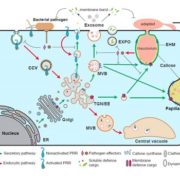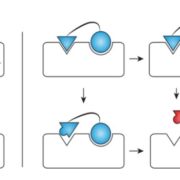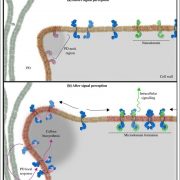Busted: Finding Cells Whose Division Planes Defy Prediction
Every plant organ, from tuber to tepal, is formed by cells that divide along precisely placed cell plates. While much is known about the molecular biology behind cell plate formation (e.g., Gu et al., 2016), why cells divide where they do is much less clear. Dividing cells have much in common with soap bubbles, which assume rounded shapes with the minimum surface area to reduce the energy associated with surface tension (Besson and Dumais, 2011). Like soap bubbles, cells divide into equally sized daughter cells via a division plane with the smallest surface area possible. This century-old concept, soap film minimization, might well describe the physics behind cell division plane specification, but plant cells don’t always follow the rules. For example, plant cells divide asymmetrically during root development and in response to external cues such as wounding. In such instances, biological regulation kicks in to guide the plant’s shape to best suit its needs. Pinpointing processes in which the choice of cell division plane deviates from the rules of soap film minimization would thus uncover processes under strong biological control, making them ripe for analysis.
While soap film minimization makes sense conceptually, this theory has only recently been examined mathematically due to the complexity of the calculations required. In a pioneering study, Martinez et al. (2018) developed a 3D geometry-based model to generate local minimum areas of predicted divisions for any cell shape (soap film minima). The authors gathered data for their model by taking confocal micrographs of maize (Zea mays) leaf epidermal cells and noted the locations of the preprophase band (PPB) in each cell, as PPB location accurately predicts the future division plane. After extracting the data, importing it into Surface Evolver software, and performing 3D mathematical modeling, a process known as gradient descent revealed the soap-film minima where cells would divide into two daughter cells of equal volume.

In most cases, the predicted soap-film minima matched the locations of PPBs in maize cells. However, like bricks in a wall, cells in adjacent files appeared staggered. Instead of forming PPBs in the predicted regions, some cells were somehow influenced by their neighbors to shift PPB formation to avoid creating a four-way junction that may weaken the mechanical strength of the tissue. Time-lapse imaging successfully captured such events in vivo. This finding points to an active mechanism for avoiding the creation of four-way junctions that bypass cell geometry.
Cells in young maize leaves tended to undergo more longitudinal divisions than those in older leaves. The model underpredicted such divisions, suggesting that developmental or mechanical forces also help orient the final division plane. Since periclinal divisions were predicted to occur ~7% of the time but rarely occur in the epidermis, the authors looked at developing maize ligule cells. These cells expanded outwardly (in the Z-plane) prior to periclinal division (see figure), suggesting that directional cell expansion may ultimately drive periclinal division in developing ligules.
To test their model’s generality, the authors analyzed other cell types, including Arabidopsis thaliana guard cells and nematode (Caenorhabditis elegans) embryonic cells. Following time-lapse imaging, the data were subjected to soap-film minimization, which accurately predicted division plane locations in most cases. Thus, this model could potentially be used to identify the correct placement of the division plane in cells of any shape and to highlight all-important deviations, making it an exciting tool for developmental biology.
REFERENCES
Besson, S. and Dumais, J. (2011). Universal rule for the symmetric division of plant cells. Proc. Natl. Acad. Sci. USA 108: 6294–6299.
Gu, F., Bringmann, M., Combs, J.R., Yang, J., Bergmann, D.C., and Nielsen, E. (2016). Arabidopsis CSLD5 Functions in Cell Plate Formation in a Cell Cycle-Dependent Manner. Plant Cell 28: 1722–1737.
Martinez, P., Allsman, L.A., Brakke, K.A., Hoyt, C., Hayes, J., Liang, H., Neher, W., Rui, Y., Roberts, A.M., Moradifam, A., Goldstein, B., Anderson, C.T., and Rasmussen, C.G. (2018). Predicting Division Planes of Three-dimensional Cells by Soap-film Minimization. Plant Cell 30: doi: 10.1105/tpc.18.00401
.









